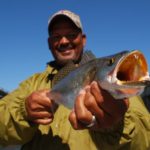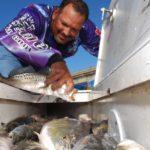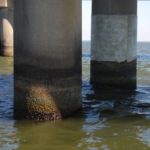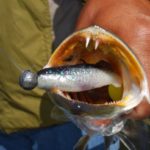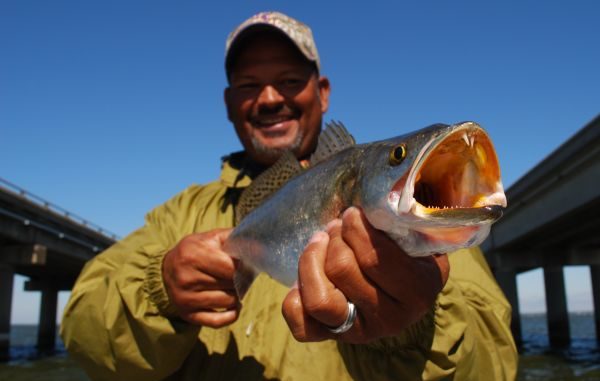
Hit a home run this month by heading to Lake Pontchartrain for some of the best trophy speckled trout fishing of the year.
CRACK!!
The sound that a white ash baseball bat makes in the dry, crisp October air is unmistakable. It’s not the hollow ping from the aluminum bats used in college and high school.
The best of the professionals put the wood to the ball every October during the Major League Baseball World Series. But they’re not the only pros at work during this beautiful month.
In Louisiana’s biggest lake, some of Louisiana’s best speckled trout anglers are hitting home runs with big speckled trout. “World Series Trout” are what Lake Pontchartrain fishermen call them.
Their appearance after the miserable dog days of summer is almost mythological. Professional fishing guide Eric Dumas isn’t sure that something magical is occurring, but he knows fine fishing when he sees it.
What is known about this mercurial lake, famous for its big trout, is that it provides a great speck bite on artificial lures in April and May and from October into December.
But, during the summer, the fish thumb their noses at fake food, probably (Dumas believes) because there is so much natural food available.
And then during the coldest months, January through March, speckled trout fishing comes almost to a halt.
But now it’s October, the day after a strong cold front and the wind was still blowing out of the north. The chill wind didn’t bother Dumas: He left the Mandeville Yacht Club boat launch at noon.
“This time of the year, I don’t never get in no hurry to come out here — 10, 11, noon,” he said. “They don’t really bite well on the Causeway (bridge) early. The better bite is as the sun gets high overhead.”
He wasn’t planning to travel far, either, sticking to the first four miles on the north end of the pair of 24-mile-long bridges.
Dumas ran halfway out to the four-mile crossover (see Causeway Geography) before pulling through both spans to begin fishing toward the south along the southbound span.
This kept the wind at his back, one of his dictums when fishing a bridge.
Using his trolling motor to move from piling set to piling set, he tossed his plastic-tipped jig at the pilings. His casts aren’t random; he probed each side of each pole and the space between the pair to find out where the fish are holding.
“What I am trying to do,” he coached, “is determine where they are — not where on the bridge, but where on the poles.”
He gave the lure four or five waggling twitches, not retrieving it much at all.
“I’m just trying to pick the bait up and drop it,” he explained.
He did this four or five times, and then reeled the lure in for another cast.
On his third cast, he yanked the first speck of the morning to the surface; it was maybe a pound or so in size.
“I didn’t feel that bite,” Dumas muttered. “The fish was just there.”
Sounding like a pool shark, he explained that the angle of a cast is important because that makes a difference in the area covered by the lure. For example, with the wind and water current out of the north, as they were that day, a cast on the south side of a pole will only allow a couple of jigs before the lure is swept away from the pole by the current.
But a cast on the north side results in the bait being swept nearer to the pole. As a result, the bait is in the strike zone longer.
Dumas believes that fish hug the poles. Some people, he said, believe trout will often pattern several feet off the poles. Not Dumas. He believes fish that strike away from a pole have simply followed the bait away from that structure.
The brisk north wind slapped the guide’s face, leaving his skin stinging like it was slapped with a baseball bat. The bright sun highlighted the man’s burnished bronze skin.
Neither the temperature nor the wind seemed to affect the trout, though. Dumas soon had six trout in the box, and had six or eight missed bites.
But he was struggling to determine a pattern, except that the fish seemed to be holding in the sunlight rather than in the shade cast by the poles.
Dumas seemed eager to share his knowledge.
“Other than not going fishing at all, the worst mistake people make is not getting their jig to the bottom,” he said. “They fish too fast. To get a 3/8-ounce jig to the bottom in 13 feet of water takes a full eight seconds.
“You can tell when it hits bottom. It throws slack at you. That is why I use florescent clear/blue Stren line. I’m a line watcher. Braided line is usable here (on the Causeway), but not where the current is strong in other famous Lake Pontchartrain fishing locations such as the CSX, Highway 90 and Tressels bridges.”
A couple of trout later, Dumas thought he was on the pattern of the day.
“Fish from the west side of the southbound lane, casting between the pilings at a 45 degree angle,” he said. “The current is sweeping the bait near the pilings.”
Eleven piling sets had produced six fish.
“About half the time I feel a thump. The other half I just feel weight — set the hook immediately,” Dumas said. “Most people want to drop the rod tip, reel up the slack and then set the hook.
“That fish is gone. Setting the hook like this takes some getting used to.”
Then, boom! He’s out of fish.
He fished a little farther, then picked up the trolling motor and used the big motor to circle the boat back beyond the area where he had received so many bites.
But in that short time, the pattern changed. He took three fish in a row off the northwestern side of the inside pole of the southbound bridge.
Dumas had earlier predicted that when the sun passed over enough to light up his favorite northwestern corner, that is where the fish would be found. And they were. Sometimes he took one off each pole in a set, and sometimes he took two off one pole.
As the bite heated up, the fish smacked the bait harder. Every fish, even the few soft-biters tried to swallow the lure. None were hooked in the lip; all were hooked in the throat.
All too soon, the spanking is over. From dock to done, in less than two hours he boxed 25 fat speckled trout and five beautiful redfish.
CRACK! It was a home run.
Eric Dumas is a featured angler in the new book Trout Masters Too: How the Pros Do It available at www.sportsmangear.com, at Amazon or for the Kindle. His charter service, Living a Dream Guide Service, can be reached at 985-705-1244 or captainericdumas@yahoo.com.
